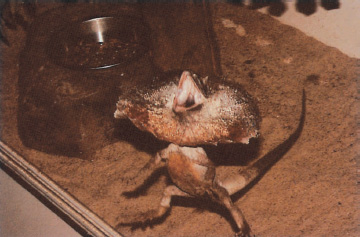
by Jerry Cole
The frilled dragon (Chlamydosaurus kingii, Grey 1825) is another Australian agamid that has attracted the attention of bearded dragon hobbyists. Large size, unusual appearance, and a docile temperament make a frilled dragon an interesting candidate if you are considering adding another type of “dragon” to your collection.
For many years, ever since the ban of reptile exports by Australia in the late 1960s, frilled dragons were lizards that most people only knew from photographs and that herpetoculturists only dreamed of owning. I saw my first frilled dragons in a popular TV advertisement in the early 1980s, while living in Japan. The flared frill, open-mouth display and ungainly bipedal running greatly amused the Japanese, sending them into fits of laughter. Although a few specimens had been offered on U.S. dealers’ lists in the 1980s, it wasn’t until 1993, with the first Indonesian exports, that these odd lizards became readily available to hobbyists in the U.S. and the U.K. This allowed hobbyists to develop the methods for keeping and breeding this species with regularity, setting the groundwork for establishing it in the hobby.
The distribution of frilled dragons is restricted to Northern Australia and Southern New Guinea, where they inhabit dry forests and savannahs. Most specimens in captivity are from Irian Jaya, the western half of New Guinea. The specimens in my possession supposedly came from the Merauke region of New Guinea. There are also a small number of frilled dragons of Australian origin established and bred in the herpetocultural hobby. The most impressive forms are said to originate from Australia’s Northern Territories. These frilled dragons tend to be larger and more colorful than Indonesian animals, with adult males also developing characteristic white cheek areas. Both Indonesian and Australian forms, as well as hybrids, are currently bred in captivity.

This frilled dragon performed a sudden bipedal leap and frilled display when photographed.
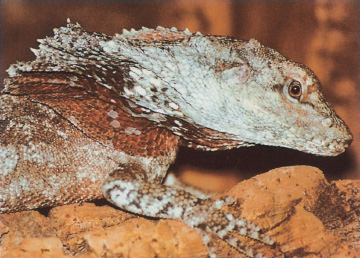
The Indonesian frilled dragon is the most readily available morph in the hobby. Photo by Jerry Cole
Frilled dragons are medium to large lizards in the family Agamidae. The average sizes and weights of the Indonesian form common in the hobby are as follows:
Males: Snout to vent is 8 inches; total length is 26 inches; average weight is about 14 ounces (400 grams).
Females: Snout to vent is 7 inches; total length is 18 inches; average weight is about 5 ounces (150 grams).
Northern Australian animals can reach a length of 36 inches and more than twice the average weight of Indonesian animals.
Frilled lizards are slender, generally mostly gray or brown with yellow and white, with varying amounts of orange or red on their frills. When threatened and during courtship these lizards open their mouths wide to extend the folded frill. It flares into a flattened disc 8–9 inches across in Indonesian animals and up to a foot across in large Australian males. The yellow inside of the open mouth contrasts sharply with the surrounding frill. If caught in the open, the frill may be displayed from a raised bipedal stance while facing the source of threat. This is a glorious display unlike anything performed by any other species of lizard. The frill is folded back against the neck and body, when it’s not in use. Because its expansion is linked to the actions of the mouth (the muscles that erect the frill are connected to the hyoid bone), the folded frill flutters when frilled dragons eat and drink.
As you can see from the size data, adult frilled dragons are relatively easy to sex on the basis of size differences. Hatchlings and juveniles are difficult to accurately sex, although as they grow older, males develop significantly larger frills (extending further down the back and front when folded) and slightly enlarged jowls. Another method for sexing is manual eversion of the hemipenes. This consists of lifting anal scales to expose the vent and using a back-to-front rolling motion of the thumb, applying pressure from the tail-base toward the vent to force the hemipenes to protrude. This method requires care and experience, but it has proven effective for sexing subadults of this species. Because of the risks of causing injury this method is not recommended with hatchlings and juveniles.
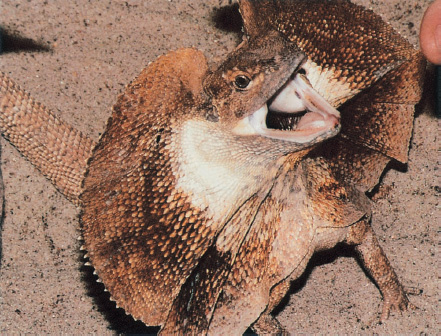
This large, colorful male “red phase” morph (displaying to its owner) originates from Australia’s Northern Territory.
Frilled lizards are relatively long-lived lizards. A male obtained as an adult lived for nine years and eleven months (Slavens and Slavens, 1996, 2000), and there are currently several living imported adults that have been in captivity for at least eight years. Adjusting for age to maturity, this suggests that this species could achieve a life span of twelve or more years.
Few lizards are more endearing than baby frilled dragons. Given regular attention that includes hand-feeding (king mealworms are particularly suitable for this purpose), frilled dragons tend to become quite tame and, in the case of males, may develop a high level of responsiveness. Only after you have seen a male frilled dragon running, body raised on its hind legs, across a room to come grab food can you fully appreciate how endearing these gangly lizards can be. However, as much as frilled dragons have many of the best qualities one could expect from a pet lizard, the fact remains that these large lizards require sizeable enclosures (five or more feet in length) as well as a minimum of heat and light sources. Frilled dragons also consume large amounts of insects and occasional vertebrate prey. Prospective owners must carefully consider these requirements.
When frilled lizards were first imported in the early 1990s, they fetched a high price, ranging from $600 to $1000 each. Fortunately, they proved to be a relatively hardy species, and now both imports and captive-bred babies are available at a fraction of their original price. Considering the risks and problems of establishing imported “frillies,” captive-bred frilled dragons should always be your first choice. Wild-collected specimens are generally heavily parasitized and many harbor mites, most readily seen in the back folds of the frills. If you choose a wild dragon, have a qualified veterinarian perform a fecal examination and treat accordingly. Spraying the mite-infested area with a solution of ivermectin usually proves effective in getting rid of these pests.
Always chose specimens with good body weight, notably around the pelvic area where the first signs of weight loss tend to become apparent. The specimens should have bright, clear eyes and an alert posture, bearing in mind that one of their defense mechanisms is to freeze and flatten themselves down when they perceive a threat. The snout and the area around the mouth should be examined for injuries or swellings. The limbs should be equal in proportion with no asymmetrical swellings, particularly at the wrists and ankles. Finally, ask to hold the lizard. It should not feel limp in your hand. The head should not hang down. Turn it around and examine the belly area. Look for red patches on the skin, which can be a telltale sign of bacterial infection. Next, examine the vent and cloacal area. The anal scales should appear flush with the body. The vent should be free of smeared fecal matter, swelling, and scabs. When you handle and examine these lizards, don’t forget about the two fanglike teeth at the front of their jaws. Don’t get bitten.

Australian male frilled dragon in full display
As babies, these lizards are very prone to threatening you with mouth and frill open wide. However, in time, most frilled lizards lose this aggressiveness and tend to become very placid animals. Once settled in captivity, they rarely display an open frill except under extreme provocation. Once habituated to the human environment, these lizards can nonetheless still be tricked into displaying an expanded frill for the purpose of putting on a show or taking photographs of a frilled dragon in full display. Techniques such as suddenly confronting them with a mirror, a quickly opened umbrella, a camera flash, a twirling lightbulb, a snake, a large lizard, or a dog have proven successful in eliciting a frilled display.
You can use cork rounds and slabs to increase activity areas for these arboreal lizards. Photo by Jerry Cole
Frilled dragons are adapted for an arboreal life, and their resting posture consists of sitting in a vertical position with the head raised. To accommodate this behavior, a large and tall cage is a must. The floor surface of the cage enclosure should obviously be determined by how many lizards you plan to keep. As a general rule, I suggest giving them as large an enclosure as you can provide. We successfully reared, maintained, and bred two male and three female frilled dragons in a 66-inch-long x 48-inch-high x 24-inch-wide cage for five years. Solid-walled enclosures with glass fronts and screen tops are ideal because they allow viewing, help increase relative humidity, and reduce the risks of snout abrasion.
As to furnishing the cage, we have found that the best substrate for these lizards seems to be bark chips, (a number of people using sand have experienced toe infections, which resulted in the loss of toes). To provide climbing areas, we add long cork bark tubes running from floor to ceiling. We also line the walls of the cages with cork bark tiles. These rough tiles, which frilled dragons can readily climb, can effectively quadruple the useable space available for the animals and enable the more nervous or subdominant individuals a better chance to avoid the more dominant ones. The cage should be maintained at approximately 75–85°F ambient temperature with a basking site heated by a spotlight that reaches 90–95°F. A reptile UV-B generating light should be used (ZooMed Repti-Sun 5.0 or similar UV bulbs). Fresh water should always be available.
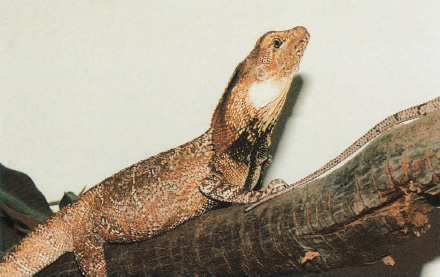
Female “red phase” frilled dragon
Unless you intend to breed your frilled dragon, you will likely find that males tend to be more interactive and lively as single pets. They also grow larger and have more colorful frills than females have. Many keepers have reported that males are generally more outgoing and display a greater degree of responsiveness than females, who tend to be shy and more likely to adopt cryptic behaviors.
Although we have had good success keeping two males and several females in the same enclosure, other breeders have reported better success housing only a single male per enclosure with multiple females. Because male frilled dragons are territorial and tend to form a dominance hierarchy when several are kept together, subdominant males may become stressed and start declining. Closely observing your animals’ behaviors should allow you to determine their compatibility.
Frilled lizards are voracious feeders and rarely present problems. We offer a variety of the following: House crickets (Acheta domestica), field crickets (Gryllus bimaculatus), locusts (Schistocerca gregaria), giant mealworms (Zophobas morio), and appropriate-sized rodents (the length of the prey body is equal or less than the head length of the lizard), are all easily available from specialist pet stores or national mail-order companies. The only times that I have ever seen my frilled dragons eat vegetation is when I have placed fresh cork-bark tubes in their cage. The dragons pick and eat the dried mosses and lichens growing on the cork bark. Chris Estep, owner of Reptile Haven, has reported that his captive-raised frilled lizards have learned to feed on watermelon offered as a treat.
We feed juvenile frilled lizards daily on small crickets (head width is a good criterion for prey size selection), dusted with a vitamin-mineral powder every other day, and with the occasional wax worm (Galleria mellonella) offered as a treat. Once they have grown to 6 inches in total length (approximately 50–100 percent of their original hatching size) we give them a pink mouse once a week and only offer crickets every other day. When they reach about 8–10 inches total length, we also start feeding them giant mealworms and medium-sized locusts. This regime continues into maturity, with the only adjustment being the size of prey, which varies according to the lizard’s size.
We provide water in large shallow pans. To assure that these lizards get enough water and to increase relative humidity, we spray the animals once daily until we observe them drinking from the water bowl.
Assuming you have both sexes in good condition, initiating breeding is not difficult. Under our husbandry regime, captive-bred and -raised frilled dragons reach sexual maturity at fifteen to eighteen months of age. To achieve successful breeding, usually you have to cycle them by manipulating several environmental factors. In the wild, frilled dragons live in dry forests and savannahs that have distinct seasons—typically long dry seasons alternated by shorter rainy seasons. To initiate breeding, simply simulate a distinct dry season followed by a rainy season.
We have consistently had good results with the following procedures. When females are in good condition we switch off their basking spotlight, which effectively drops the cage’s ambient temperature to 70–80°F. We also reduce the photoperiod (day length) from sixteen to twelve hours a day and stop spraying their cage. This is continued for six to eight weeks, during which time activity levels and food and water intake decrease dramatically. In the wild, this would correspond with the dry season, a period when these lizards retreat to the uppermost branches of their trees and effectively estivate. After this two-month rest period, the regular husbandry regime is resumed. Spotlights are turned on for fourteen or more hours a day, temperature is raised back to normal, and heavy spraying with water is performed once or twice a day. As a result, food and water intake increase dramatically.
Normally, within ten to fourteen days of a return to a rainy season (or normal) regime, the dominant male lightens in color, with the end third of the tail darkening. The male also starts becomes agitated and irritable. At this time he chooses the best vantage point in the cage to survey his territory, constantly head-bobbing, frilling, swishing his tail like an angry cat does, and rushing around the cage to assert his dominance on all cage mates. Females submit by lowering their bodies and moving their heads in a side-to-side circular movement. More rarely, they arm-wave as a submissive behavior. Like juvenile bearded dragons, frilled dragons often perform arm-waving when young and cease to do so as they grow older.
Mating is a brief procedure, a short chase during which the male bites hold of the female’s frill behind the head and pins her to the ground. Then, with his back leg, he performs scratching motions until he can lift the female’s back leg and bring their vents together. Actual mating is brief and only takes one to five minutes.
It is important to provide a large container of moistened soil or peat as a laying site for your gravid female. Photo by Jerry Cole
As a nest box, we offer female frilled dragons a tray that is 24 inches long x 15 inches wide and about 7 inches deep, with damp peat as a laying medium. When gravid females become obviously distended and their bodies appear almost pear shaped, they begin to look for a site to lay eggs. This process, which usually lasts up to two weeks before laying, consists of short burrow-digging sessions. Few problems are associated with egg-laying as long as there is a suitable laying site and the females are left undisturbed. Under our conditions, most eggs are laid in late morning or early afternoon, taking approximately one to two hours to lay. Most of the clutches laid in our facilities consist of six or seven eggs with the largest being nine. However, the larger Northern Australian frilled dragons are reported to commonly lay single clutches of twelve or more eggs with one record of a female laying twenty-three eggs (Bedford, Christian, and Griffiths 1993).
After laying, the female then covers her eggs. Interestingly, for up to twenty-four hours after laying (if the eggs are left in the nest), any disturbance to the nest area may evoke interest from the female and will lead her to tidy up again.
Baby frilled dragons are hatching from eggs half-buried in moistened vermiculite. Photo by Jerry Cole
Eggs should be removed at the first opportunity anytime after laying is completed and placed in a ventilated plastic storage container filled with 2 inches of lightly dampened vermiculite. Bury the eggs on their sides in the incubating medium so that two-thirds of each egg remains exposed. Then place the container into an incubator set at 83–85°F. Hatching occurs between eighty and ninety days (this is also about the period required for our females to lay the next clutch—one clutch in, one clutch out!).
Although some breeders have recommended higher incubation temperatures, others have indicated that high temperatures can lead to delayed development and a high rate of embryo death (pers. comm. Bob Mailloux; and Weis 1996). Those who successfully hatch frilled dragons using incubation temperatures that exceeds 85°F usually allow significant day/night fluctuations with night drops into the upper 70s (°F). There was a study in which they measured the ground temperature of the nests of Northern Territory frilled dragons and obtained average measurements (midmorning/late afternoon) of 85°F and 89°F (Bedford, Christian, and Griffiths 1993). These data suggest the possibility that there could be variations in incubation tolerances between the different forms, that is, between Indonesian and Australian frilled dragons. There is also evidence that in frilled dragons, incubation temperature may determine sex. A preponderance of males in the many clutches we have hatched at 85–86°F supports the possibility of temperature-dependent sex determination. Others have reported higher female ratios if the eggs are incubated at 82–83°F. Clearly this information suggests the subject of incubation in this species warrants further investigation
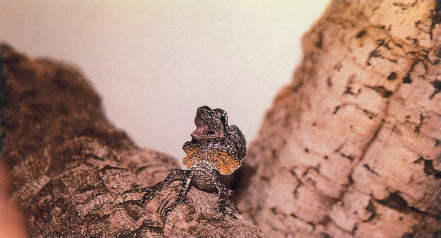
Few lizards are as endearing as hatchling frilled dragons. Photo by Jerry Cole
After the egg are slit, frilled babies stay inside the shell for up to twenty-four hours before emerging. They should never be disturbed during this period. Once out, they enter a stage in which they lie still and look like they are dead for another twenty-four hours. Although they don’t do much during this period, the hatchlings are still fun to watch. Baby frilled lizards are among the most endearing young reptiles, with high-contrast patterns that are far crisper and bolder than on adults.
In the wild, I believe frilled dragons probably lay one to three clutches of eggs annually, depending on a combination of factors including availability of food and water and climatic conditions. In captivity, if conditions are right, they can dramatically exceed this rate. Our F1 (first generation captive-bred) frillies of early 1995 were cycled in mid-1996. Two females then started to lay a clutch of eggs every eighty to ninety days and did not stop until October 1999, even when subjected to a simulated dry season. The fertility of the many clutches was 100 percent.
To help females survive this kind of intensive breeding, be sure to provide ample amounts of high-quality food. The importance of caring for fertile females becomes particularly evident once you consider that a clutch of eggs can represent 20–30 percent of a female’s body weight. Captive female frilled dragons have such a strong drive to reproduce that it can override their ability to sustain themselves. Only heavy feeding can allow a female to regain enough weight to allow her to lay again three to ten weeks later and remain healthy.
Once established, frilled dragons are generally a hardy lot; even imports may live many years with few health problems. However, among imports, parasites are a common problem that must be diagnosed and treated. Additionally, adult imports can initially be restless, and if kept in too small or abrasive enclosures such as wire mesh, they may damage their snouts. This is best prevented by providing the right type of enclosure with cork tubes, angled branches, or small trees to give these animals a sense of security and the opportunity to hide from view.
Captive-bred specimens, although usually better acclimated, are not necessarily problem-free. Possibly because many breeders of frilled dragons also work with bearded dragons, both pinworms and coccidiosis (the bane of bearded dragon breeders) have been reported in captive-bred frilled dragons. As a rule, an animal that fails to gain or maintain weight should always be checked for parasites by a qualified reptile veterinarian. In babies, as with most other insect-eating lizards, metabolic bone disease (soft bones leading to deformities, inability to feed and/or move) caused by inadequate availability of calcium is of special concern. Prevent this disease by providing a high-quality diet supplemented with a vitamin/mineral supplement and a UV-B light source. Frilled lizards also risk damage to the frill from trauma or tearing. Shedding problems also sometimes occur when these lizards are kept too dry, at a low relative humidity, and without regular misting. In older animals, gout, apparent as hard swellings of the ankle or wrist areas, has been reported with some frequency. Suspected causes of this disorder include inadequate hydration, or feeding animals kept at suboptimal temperatures.
It is only recently that some attention has been brought to reptile geriatrics, notably by reptile veterinarian John Rossi (Rossi and Rossi 1996) and more recently by de Vosjoli, Donoghue, and Klingenberg (1999). The latter presented an ontogenetic framework (called life stages) as a basis for adjusting husbandry practices.
How does one care for old frilled dragons? If they are sick and requiring labor-intensive and costly care, the reasonable thing to do is to opt for humane euthanasia. On the other hand, many of the larger lizards, like people, seem to simply get old and require a little extra care. Because many old lizards have been long-term responsive pets—almost members of the family—it is natural for attached owners to want to provide supportive care in the last stages of their lives.
Some of the ailments of old frilled lizards include opacities of the lens that can result in partial blindness, decreased activity, and gout. Eventually this disabled stage leads to an extended period of inactivity that can last several weeks, sometimes months, prior to death. Supportive help during these senior and terminal stages usually means hand-watering, bringing food within easy reach, or even hand-feeding, and maybe even helping an aging, disabled frillie to move in and out of the sun.